45 human heart with labels and function
Label the heart — Science Learning Hub In this interactive, you can label parts of the human heart. Drag and drop the text labels onto the boxes next to the heart diagram. If you want to redo an answer, click on the box and the answer will go back to the top so you can move it to another box. If you want to check your answers, use the Reset Incorrect button. Labelling the heart — Science Learning Hub The heart is a muscular organ that pumps blood through the blood vessels of the circulatory system. Blood transports oxygen and nutrients to the body. It is also involved in the removal of metabolic wastes. In this activity, students use online and paper resources to identify and label the main parts of the heart.
Parts Of The Human Heart | Science Trends But few people know all its parts and their essential functions. Broadly speaking, the human heart has one function: to pump blood through the circulatory system all throughout the body, thus supplying both nutrients and oxygen to the body's tissues while also removing all the wastes, including carbon dioxide. The Anatomy of the Human Heart

Human heart with labels and function
Heart: Anatomy and Function - Cleveland Clinic Your heart is the main organ of your cardiovascular system, a network of blood vessels that pumps blood throughout your body. It also works with other body systems to control your heart rate and blood pressure. Your family history, personal health history and lifestyle all affect how well your heart works. Appointments 800.659.7822 Human Heart Diagram Labeled | Science Trends The heart's primary function is to supply the tissues of the body with oxygen and rid the body of carbon dioxide. The pulmonary circuit and the systemic circuit are the two systems of the body that enable the heart to accomplish this. Deoxygenated blood is oxygenated as leaves through the pulmonary circuit. The 18 parts of the human heart, and their functions The 18 parts of the human heart and how they work 1. Myocardium 2. Endocardium 3. Pericardium 4. Right Auricle 5. Right ventricle 6. Tricuspid valve 7. Pulmonary valve 8. Left Auricle 9. Left ventricle 10. Mitral valve 11. Aortic valve 12. Tendon cords 13. Papillary muscles 14. Sinus node 15. Atrioventricular node 16. Atrioventricular fascicule 17.
Human heart with labels and function. Heart Labeling Quiz: How Much You Know About Heart Labeling? Here is a Heart labeling quiz for you. The human heart is a vital organ for every human. The more healthy your heart is, the longer the chances you have of surviving, so you better take care of it. Take the following quiz to know how much you know about your heart. Questions and Answers. 1. Human Heart (Anatomy): Diagram, Function, Chambers, Location in Body The heart pumps blood through the network of arteries and veins called the cardiovascular system. The heart has four chambers: The right atrium receives blood from the veins and pumps it to the... Human Heart - Anatomy, Functions and Facts about Heart - BYJUS Following are the main functions of the heart: One of the primary functions of the human heart is to pump blood throughout the body. Blood delivers oxygen, hormones, glucose and other components to various parts of the body, including the human heart. The heart also ensures that adequate blood pressure is maintained in the body A Labeled Diagram of the Human Heart You Really Need to See The human heart, comprises four chambers: right atrium, left atrium, right ventricle and left ventricle. The two upper chambers are called the left and the right atria, and the two lower chambers are known as the left and the right ventricles. The two atria and ventricles are separated from each other by a muscle wall called 'septum'.
How to Draw a Human Heart: An Easy Step-By-Step Guide - wikiHow Method 1Sketching the Heart. 1. Draw a tilted and irregular curved shape in the center of your page. Use a pen or pencil to draw the heart's main body. Create a curved shape similar to an acorn or apple's bottom half. Angle the slightly tampered end of the shape to the left about 120 degrees. [1] 13 parts of the human heart (and its functions) - LORECENTRAL Parts of the heart and its functions 1. Left atrium 2. Mitral Valve 3. Left Ventricle 4. Aortic sigmoid valve Right atrium 6. Tricuspid valve 7. Right ventricle 8. Pulmonary sigmoid valve 9. Atrial septal defect Interventricular partition 11. The sinus or sinoatrial node 12. Atrioventricular or Aschoff-Tawara nodule 13. Hiscules and Purkinje fibers Heart Diagram - 15+ Free Printable Word, Excel, EPS, PSD Template ... Teachers and students use the heart diagram, in biological science, to study the structure and functions of a human being's heart. ... Label The Parts Of The Heart. depts.washington.edu | Having the heart diagram for studies or for scientific purpose has been made easy through this template. It shows a heart picture with all its parts labeled ... Human heart: Anatomy, function & facts | Live Science The human heart is located in the center of the chest - slightly to the left of the sternum (breastbone). It sits between your lungs and is encased in a double-walled sac called the pericardium,...
Anatomy of the Human Heart - Physiopedia Anatomy. The heart has a somewhat conical form and is enclosed by the pericardium. It is positioned posteriorly to the body of the sternum with one-third situated on the right and two-thirds on the left of the midline. The heart measures 12 x 8.5 x 6 cm and weighs ~310 g (males) and ~255 g (females) Relations. How the Healthy Heart Works | American Heart Association How the Healthy Heart Works. The normal heart is a strong, hard-working pump made of muscle tissue. It's about the size of a person's fist. The heart has four chambers. The upper two chambers are the atria, and the lower two are the ventricles (Figure A). The chambers are separated by a wall of tissue called the septum. Cross Section of the Heart Diagram & Function | Body Maps - Healthline Cross-section. The chambers of the heart operate as a 'double-pump' system for the body's circulation. In coordination with valves, the chambers work to keep blood flowing in the proper ... What Are the Four Main Functions of the Heart? - MedicineNet The four main functions of the heart are: Pumping oxygenated blood to other body parts. Pumping hormones and other vital substances to different parts of the body. Receiving deoxygenated blood and carrying metabolic waste products from the body and pumping it to the lungs for oxygenation. Maintaining blood pressure.
The Anatomy of the Heart, Its Structures, and Functions - ThoughtCo The heart is the organ that helps supply blood and oxygen to all parts of the body. It is divided by a partition (or septum) into two halves. The halves are, in turn, divided into four chambers. The heart is situated within the chest cavity and surrounded by a fluid-filled sac called the pericardium.
Human Heart - Anatomy and Functions | Location and Chambers - VEDANTU The human heart is the organ that pumps blood throughout the body via the vessels of the circulatory system, supplying oxygen and nutrients to the tissues and removing carbon dioxide and other wastes. Pumping the blood through the arteries, capillaries, and veins is the major function of the heart. It maintains proper circulation of blood.
Diagram of Human Heart and Blood Circulation in It Your heart has four types of valves with primary function of regulating the blood flow through the heart. Every heart diagram labeledwill clearly show these valves. These valves allow blood flow in one direction only. Different valves perform different functions.
Free Heart Worksheets for Human Anatomy Lessons - Homeschool Giveaways The human heart is a strong muscular organ. It's responsible for pumping blood throughout the body. It's located behind and slightly to the left of the breastbone and is about the size of a fist. The heart brings oxygen-rich blood and nutrients to the cells and allows the body to remove the waste product and carbon dioxide from the cells.
Heart (Human Anatomy): Overview, Function & Structure | Biology The heart is a muscular organ that pumps blood throughout the body. It is located in the middle cavity of the chest, between the lungs. In most people, the heart is located on the left side of the chest, beneath the breastbone. The heart is composed of smooth muscle. It has four chambers which contract in a specific order, allowing the human ...
Chest and the Heart Diagram & Function | Body Maps - Healthline The average human heart weighs between 6 and 11 ounces. The muscle is strong enough to pump up to 2,000 gallons — as much as a fire department's tanker truck — of blood through one's body ...
Human Heart - Diagram and Anatomy of the Heart - Innerbody The heart functions by pumping blood both to the lungs and to the systems of the body. To prevent blood from flowing backwards or "regurgitating" back into the heart, a system of one-way valves are present in the heart. The heart valves can be broken down into two types: atrioventricular and semilunar valves. Atrioventricular valves.
Human Heart for Kids: 2 Fun Heart Models plus Worksheets An adult's heart weighs about 8-12 ounces and pumps blood by squeezing and relaxing in a regular rhythm. We call this rhythm a heartbeat. Your heart beats an average of 70 times per minute pumpking more than 4 quarts of blood through your heart every minute. Then we dove in deeper with these fun heart books for kids. Heart Science Project
heart | Structure, Function, Diagram, Anatomy, & Facts In humans and other mammals and in birds, the heart is a four-chambered double pump that is the centre of the circulatory system. In humans it is situated between the two lungs and slightly to the left of centre, behind the breastbone; it rests on the diaphragm, the muscular partition between the chest and the abdominal cavity. Britannica Quiz
How our heart works - Structure and function (3D animation) - In ... The video explains how our human heart works - its structure and function of each part.About us: We are a social enterprise working on a mission to make scho...
Heart Diagram with Labels and Detailed Explanation - BYJUS The human heart is the most crucial organ of the human body. It pumps blood from the heart to different parts of the body and back to the heart. The most common heart attack symptoms or warning signs are chest pain, breathlessness, nausea, sweating etc.
The 18 parts of the human heart, and their functions The 18 parts of the human heart and how they work 1. Myocardium 2. Endocardium 3. Pericardium 4. Right Auricle 5. Right ventricle 6. Tricuspid valve 7. Pulmonary valve 8. Left Auricle 9. Left ventricle 10. Mitral valve 11. Aortic valve 12. Tendon cords 13. Papillary muscles 14. Sinus node 15. Atrioventricular node 16. Atrioventricular fascicule 17.
Human Heart Diagram Labeled | Science Trends The heart's primary function is to supply the tissues of the body with oxygen and rid the body of carbon dioxide. The pulmonary circuit and the systemic circuit are the two systems of the body that enable the heart to accomplish this. Deoxygenated blood is oxygenated as leaves through the pulmonary circuit.
Heart: Anatomy and Function - Cleveland Clinic Your heart is the main organ of your cardiovascular system, a network of blood vessels that pumps blood throughout your body. It also works with other body systems to control your heart rate and blood pressure. Your family history, personal health history and lifestyle all affect how well your heart works. Appointments 800.659.7822




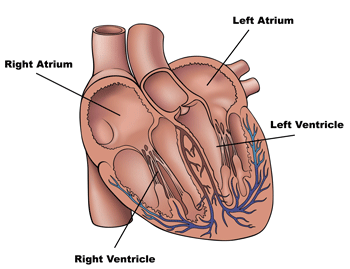





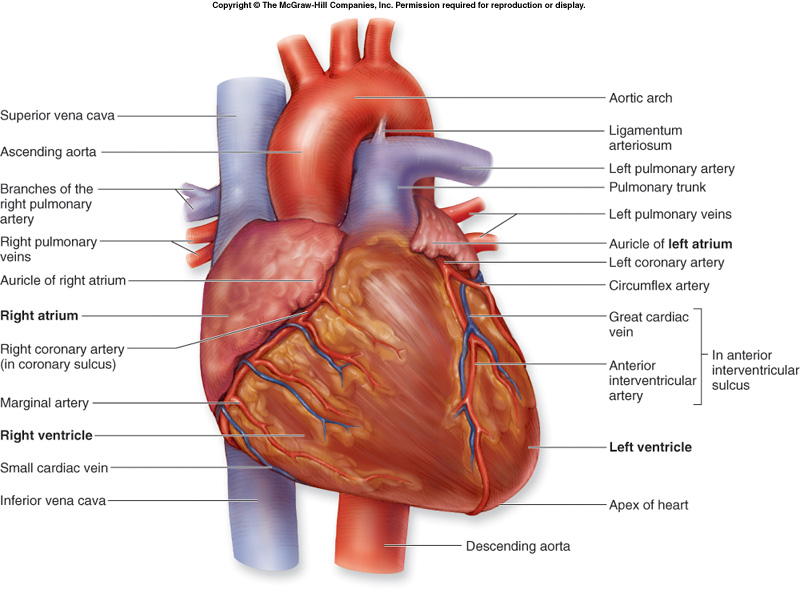

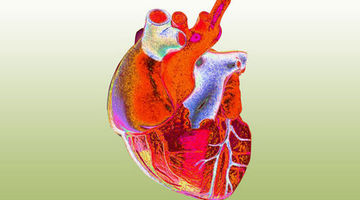
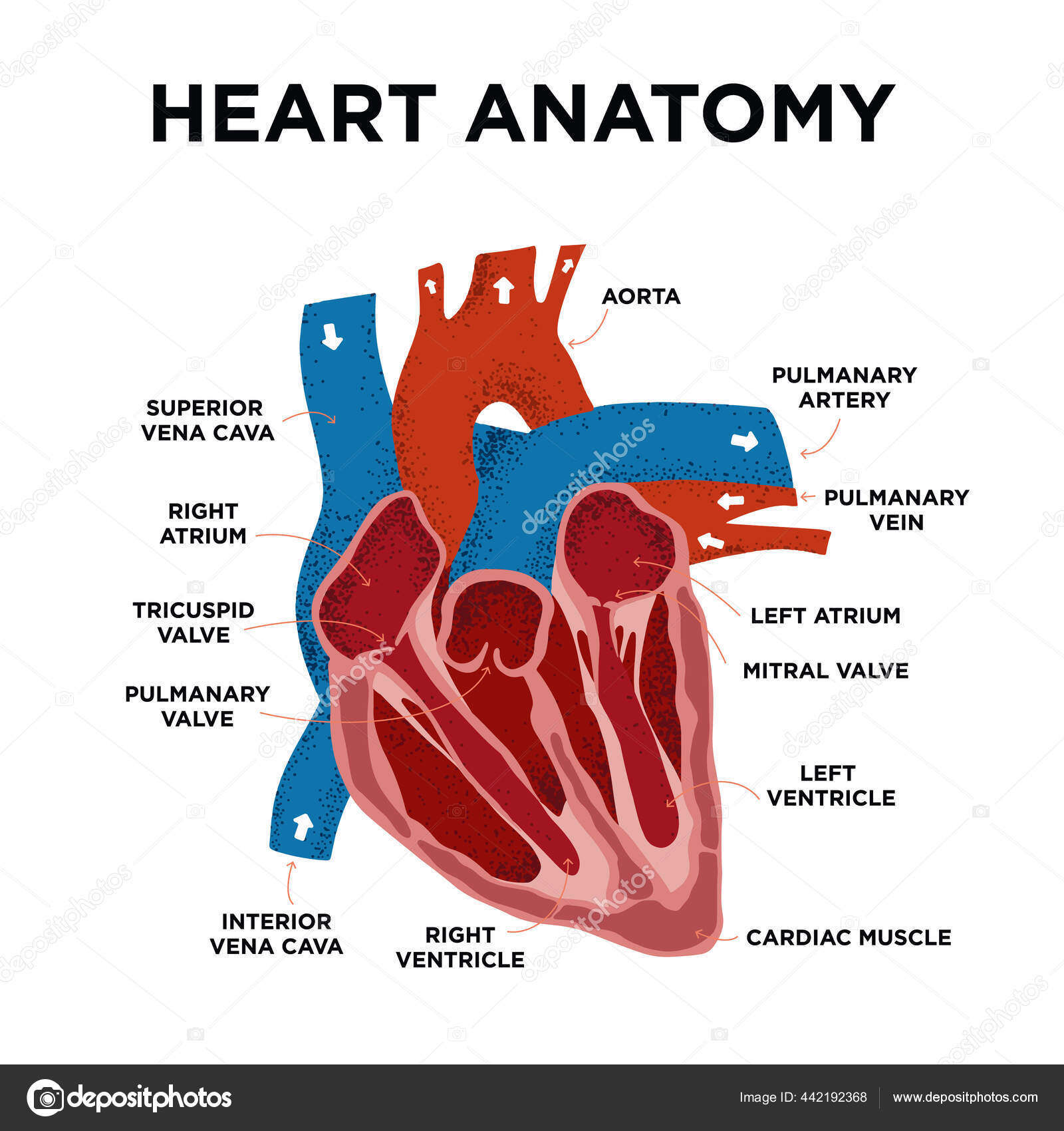



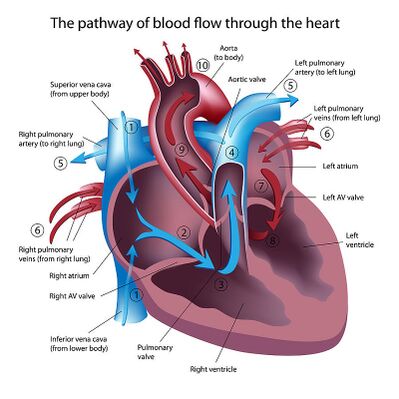
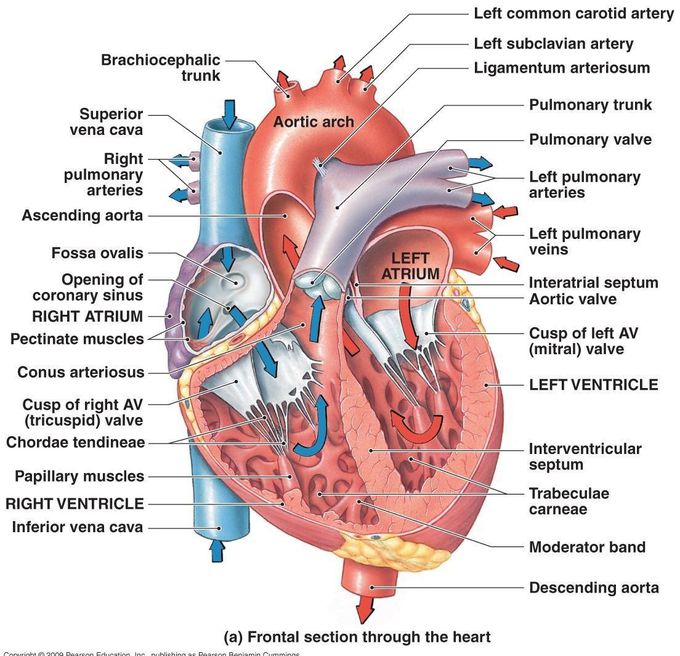




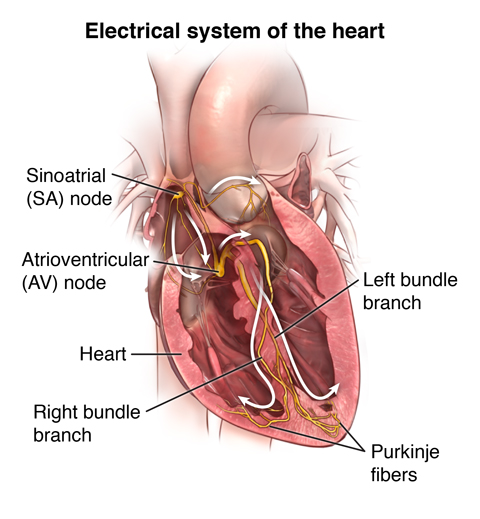

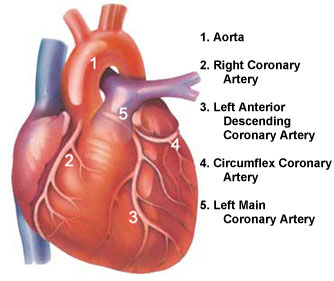









:max_bytes(150000):strip_icc()/heart_cross-section-57ed79845f9b586c3512474e.jpg)
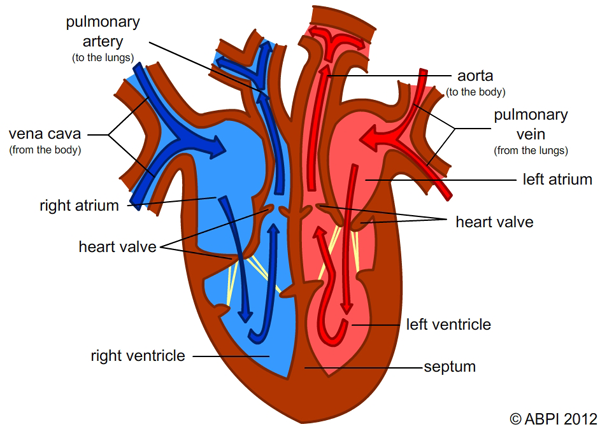
Post a Comment for "45 human heart with labels and function"